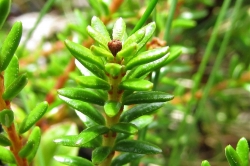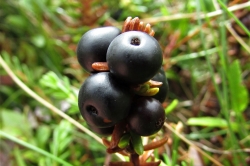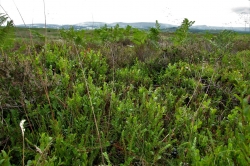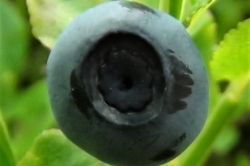crowberry, (genus Empetrum), genus of three species of low evergreen shrubs of the heath family (Ericaceae). The plants thrive in subarctic, alpine, and boreal regions and produce juicy edible fruits that are somewhat acidic in taste. The fruits are an important food source for numerous species of songbirds and waterfowl as well as bears, voles, and other mammals. They have a long history of use by indigenous peoples as a food and medicine.
Physical description
Crowberries grow about 25 cm (10 inches) tall and are somewhat trailing in habit. The narrow simple leaves are about 1 cm (0.4 inch) long and somewhat succulent. The flowers are very small and purplish pink. The fruits are true berries, about 1 cm long, and range from reddish to purple to black, depending on the species.
Species
Crowberry, or black crowberry (Empetrum nigrum), is native to cool regions of North America, Asia, and Europe and is the most common species of the genus. Purple crowberry, or rockberry (E. eamesii), is found in the northeastern United States and eastern Canada, and red crowberry (E. rubrum) is native to Chile, Argentina, and the Falkland Islands.

| Status | Green – Least concern |
|---|---|
| Best Time to See | May, June |
| Colour | Purple |
| Habitat | Wetland, Upland |
A mat-forming shrub with tiny purple, stalkless, starry flowers that nestle between needle-like leaves.
The edible berries of this evergreen shrub cluster around the stalk, but tend to be fairly tasteless and low in vitamins. The blueberry-like berries start green and turn pink before finally becoming black and can persist into the winter if not picked.
Where to find Crowberry.
Crowberry is found on moors, bogs and wet mountain slopes. It grows in acidic soils in shady, moist areas. It is widespread throughout Scotland.
How’s it doing?
This wild plant is commonly found in its preferred habitats.
Did you know?
- Otherwise known as black crowberry or simply blackberry, crowberry has many local names including berry-girse, crane, crawberry, crawcrooks, crow ling, lingberry, monnocs-heather, deer’s grass and she-heather.
- In terms of uses, it can be grown for the edible fruit, as an ornamental plant in rock gardens (notably the yellow-foliaged cultivar ‘Lucia’) or as a ground cover.
- The fruit’s high content of anthocyanin pigment make it useful as a natural food dye.

Crowberry’s generic name Empetrum, literally means “growing on rocks”. This evergreen shrub sheds its leaves only once every two to four years and it can grow in very poor soil conditions.People cultivate crowberry as a source of food, as a ground cover and for ornamental purposes. Crowberry is perennial shrub that belongs in the heather family that can survive more than 20 years in the wild.
Distinguishing Features
Crowberry has narrow, simple leaves. Their sides are curled backwards. Leaves are light green and alternately arranged on the stem. Fruit of crowberry is black, dark purple or red berry-like drupe. Fruit ripens in the fall and remains on the shrub until the spring making it a great source of food in the winter. The berries are about the size of a pea.
Flowers
Crowberry is typically blooms anywhere from May to August. Magenta-coloured flowers are small, individual flowers and the seeds ripen in September. Flowers are pollinated by bees, flies, butterflies and moths. Flowers have three petals, three sepals and three stamens.
Leaves
Crowberry leaves are alternate,whorled, stalkless, and they overwinter. They are small and grow only to about 5mm (.20”) in length. The blade is linear, needle-like, hollow, and the margin is curled downwards. The lower surface has a pale, hairy stripe. Crowberry leaves are covered with glands that produce toxic substances. When they fall to the ground and start to decompose, leaves release toxins into the soil that prevents growth of other, competing plant species.
Height
Although it tends to stay low to the ground, crowberry can grow to 30cm in height (12″). Typically it is about 10cm (4″) tall.The stem is limp and is often reddish.
Habitat
This bush is found in forest heaths, rocky outcrops, barren bogs and in sandy locations in the Arctic and sub-Arctic regions around the world. It prefers slightly acidic soil. They are native to the norther regions of Europe, Asia and North America. Interestingly, they are found in abundance on the Falkland Islands. They grow in most areas across Canada and in the northern and western areas of the U.S.
Edible Parts
The berries are the only edible part although the twigs can be used as tea. They ripen in autumn and remain on the bush throughout the winter. Crowberries can be eaten raw but taste better after they have been exposed to a heavy frost. The taste somewhat acrid and are generally used for making pies, wine, jams, jellies, etc. They are an excellent source of fibre and antioxidants – even better than blueberries. They are high in vitamins C and K. Crowberry is used for smoking fish in some northern cultures.
Other Name
Mossberry.
Leaves
The leaves are small, short, fleshy, almost succulent and glossy. They grow in large numbers spiralling along the stringy stems. Small pink five petalled flowers grow from between the leaves in spring and early summer.
Fruit
The fruits look a little like small Bilberries that grow in clusters along the stem. They start pink before turning red then to black and can persist on the plant from early summer well into winter and even spring.
Possible Confusion
Can look a little like Bilberries, pictured, but the lack of ‘cogwheel’ and very different leaves should save confusion although these two plants will happily grow with each other in the same environment.
The leaves could be confused with some of the Stonecrops but these don’t have black berries growing along the stem.
Taste
The berries have a subtle taste and are best dried or cooked with other fruit.
Frequency
Common in upland areas of moor and acidic soil around the UK.
Other Facts
The berries are high in anthocyanin and have been used as a dye for foods.





